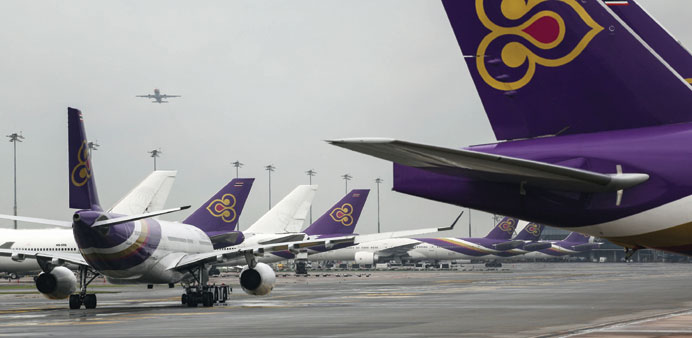Aircraft operated by Thai Airways stand on the tarmac at Suvarnabhumi Airport in Bangkok. Thai Airways and Singapore Airlines are facing increasing headwinds from fierce competition.
By Arno Maierbrugger
Gulf Times Correspondent
Bangkok
Thai Airways and Singapore Airlines, once successful and independent national airlines with strong brand names and huge regional and global networks, are facing increasing headwinds from fierce competition not only from regional low-cost carriers which are pushing fares down, but more so from Middle East carriers on long-haul routes, changing the business model of formerly established Southeast Asian full-service carriers profoundly. Airline analysts from Sydney-based Centre for Asia Pacific Aviation call the situation already “severe” and “bordering on a crisis.”
Thai Airways International, in operation since 56 years, on November 11 was forced to announce record losses of $503mn for the first nine months of this year, up 97.2% from the same period last year, triggering fears that its full-year loss could equal or exceed the all-time high of $592mn in losses posted in times of the financial crisis in 2008.
The announcement of the results was embarrassing for new Thai Airways President Charamporn Jotikasthira, former president and CEO of the Stock Exchange of Thailand, who was appointed head of the national airline in December 2014 and back then announced a “major revamp” to lead the airline back to profitability – but so far failed to stop the carrier’s financial haemorrhage.
However, at a press conference in Bangkok on the same day of the loss announcement, Jotikasthira was quick to name those whom he blames for the problems of Thai Airways: Asia’s low-cost carriers, and, on the previously profitable long-haul routes to Europe, airlines from the Gulf.
He explained that, in the past, Bangkok, along with Singapore and Hong Kong, was a busy transit stop for passengers travelling from Europe to Indonesia, Australia or Japan.
But with the rise of Gulf carriers – namely Emirates, Etihad Airways and Qatar Airways – as well as in the wake of cheaper fuel and more fuel-efficient planes, air traffic routes have shifted.
Travellers from Europe now take a flight to Dubai, Abu Dhabi or Doha and can continue directly to destinations in Asia-Pacific, “simply flying over our heads,” the Thai Airways chief complained.
Thailand’s open sky policy is also a factor. It allows foreign carriers to fly to Thailand and continue their flight to another destination in the region. Seats on this so-called “last legs” are sometimes offered very cheaply as airlines are struggling to fill the plane.
For example, Kuwait Airways has a direct flight from Kuwait City to Bangkok which is almost always fully booked, and then continues on the route from Bangkok to Manila with a half-empty plane for which seats are sold for around a third of what travellers would pay for a Thai Airways flight on the same route – and both are full-service airlines with meals and free luggage.
Similarly, Qatar Airways has a “last leg” from Bangkok to Hanoi and in addition operates a regional codeshare with Thai Airways’ competitor Bangkok Airways. Moreover, facing the fact that – according to the UK-based airline data firm OAG – Emirates alone has already about 13% share of the number of passengers flown between Western Europe and Southeast Asia, and Qatar Airways and Etihad Airways are occupying 9% and 6% respectively of this market transiting via the Gulf, Singapore Airlines – which has the second highest market share on direct Europe – Southeast Asia flight behind Thai Airways – has been pressed into ending its formerly much-esteemed independence.
The city state’s prestigious airline is now entering a revenue-sharing joint venture with Germany’s Lufthansa on certain Europe-Southeast Asia routes that include codeshare flights also with Austrian Airlines, Swiss and SilkAir and cooperation on key markets in Southeast Asia and in Australia in an aim to combat the seemingly more effective Gulf rivals.

